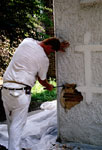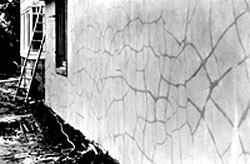
Long known for its versatile appearance, ready availability, and durability, portland cement plaster remains a popular finish for many buildings, from commercial to residential. However, damage can occur, whether on older installations or poorly installed newer ones.
Moisture management is a top priority in a stucco installation because water is one of the major culprits in plaster deterioration. It can lead to rust and rot. It enters the building through cracks, through the roof, around chimneys, or through window and door openings. It can get behind building paper that is torn or not properly lapped at seams. Portland cement plaster is a breathable material that does allow moisture vapor to pass through, so it is capable of drying out and does not trap moisture.
In any case, repair is a straightforward procedure that can bring the surface back to good condition.
Before beginning any repair, you should make sure that the walls are structurally sound and that there are no hidden problems. You don’t want to mask something major by addressing the cosmetics. Plaster repair is a straightforward procedure that is capable of bringing many stucco surfaces back to good condition.
 Repairing portland cement plaster (stucco) around a window
Repairing portland cement plaster (stucco) around a window
Older plaster surfaces can become worn or faded upon exposure to weather, such as rain, snow, and sunshine. Today’s pigments are compatible with cement-based materials and are durable over the long term. Pigments should meet the requirements of ASTM C 979, Standard Specification for Pigments for Integrally Colored Concrete.
A wall that was poorly cured following installation may exhibit minor cracks on the surface. Even minor cracking can detract from the look of an otherwise good quality wall. As long as cracks are not too wide so that water passes through them, a new finish treatment can be a quick fix. That could be a portland cement-based paint or a slurry of cement and pigments, sometimes call a fog coat. Another reason to recoat a plaster wall is that your building may need a new look, which can be accomplished simply by updating the color.

Map cracking on a portland cement plaster (stucco) wall. This is often caused by improper curing.
At worst, the walls may be damaged due to moisture infiltration, building settlement, or other environmental factors. When this is the case, it’s best to consult professionals because a poorly executed repair won’t last and might mask the problem until even more damage is done.
Resources
Portland Cement Plaster/Stucco Manual, EB049
Repair of Portland Cement/Stucco, IS526
Contact Jamie Farny, PCA Market Manager, Buildings.
The American Society for Testing and Materials (ASTM) generates consensus documents with the input of many people, including contractors, engineers, architects, and material producers/suppliers. They agree on what constitutes “best practice” and develop standards to reflect that.
ASTM Standards www.astm.org
ASTM C 926, Standard Specification for Application of Portland Cement-Based Plaster
ASTM C 1063, Standard Specification for Installation of Lathing and Furring to Receive Interior and Exterior Portland Cement-Based Plaster